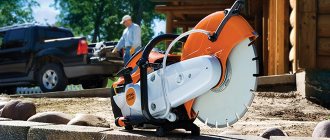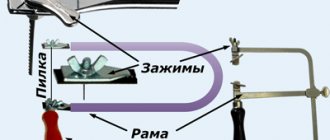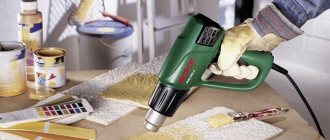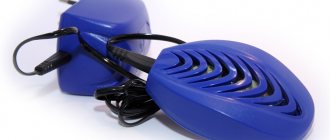What is a renovator
A multitool is a wide-ranging household device that can cope with a variety of tasks. A video about what a renovator can do demonstrates that he can process soft linoleum, wood or even metal with equal ease, allowing him to perform work that is simply impossible to do with other tools.
Renovator is a universal device for cutting and grinding hard and soft materials
The multifunctional renovator is a fairly “young” unit, invented only about 50 years ago. Initially, it was used only in medicine to remove plaster after fractures. But subsequently the tool was improved, equipped with a gearbox and introduced to the automotive and construction markets.
Currently, a multitool is a vibration-type unit for cutting and grinding a wide variety of materials. It is equipped with numerous removable attachments, and is used primarily as an auxiliary device. The renovator’s capabilities are used for small jobs or in places that simply cannot be reached with specialized tools.
Grinding and polishing work
Nozzles of various shapes are used for grinding and polishing various surfaces. For example, round ones are good for processing large surfaces, and small triangular ones are convenient for working in corners or other hard-to-reach places.
They are used both for rough processing of various materials (stone, metal) and for fine grinding of surfaces made of wood or plastic. To do this, pads made of sandpaper of different grain sizes, as well as a sponge or felt, are attached to the nozzle with Velcro. Felt pads are used to polish the surface.
Renovator device
Externally, the multitool is most similar to a grinder, or an angle grinder. The body of the instruments is almost the same, although the renovator is slightly smaller in size and lighter in weight.
Inside the device there is a motor powered by an electric drive. When put into operation, the motor transmits torque to the spindle with an eccentric, which causes the clamp with the selected attachment to vibrate. As a result of fast and frequent oscillations, the nozzle moves left and right in a range of only 3-4 °.
The multitool is equipped with special attachments for different materials. Important! Since the equipment is usually fixed using a hex wrench or a clamping device, the attachment cannot fly off even during prolonged vibration.
Operating principle and design.
The renovator’s work is based on the principle of oscillation (from the Latin oscillum - oscillation). In the general case, the oscillatory motion of the clamp with the working attachment is imparted by an electric motor, the shaft of which, rotating at high speed (1000...35000 rpm), is connected to a spindle equipped with an eccentric.
It is the eccentric that forms and, with the help of a special fork, transmits oscillatory movements to the working head of the multi-cutter, the amplitude of which, as a rule, is no more than 2...3°.
Structurally, the renovator is a power tool, in the elongated body of which the following are fixed:
- electric motor with oscillating drive;
- electronic speed controller;
- attachment mechanism.
The tool is designed for long-term use, which is ensured by:
- the use of high-quality steel in the manufacture of critical parts of the kinematic circuit;
- a large amount of grease, which contains all the friction units responsible for transmitting vibrations to the working head;
- the presence of a soft start device and an oscillation frequency regulator.
What is the purpose and function of the renovator tool?
The purpose of a renovator is very broad and is not limited to just one area. The tool is used for dozens of different jobs, most often in cases where for some reason it is necessary to replace highly specialized equipment. For example, a renovator can be taken instead of a grinder, jigsaw, grinder or hacksaw if you need to process a place where a regular tool simply cannot reach.
Multitools are actively used by builders and repairmen, installers and woodcarvers, bodybuilders and sculptors. Thanks to a variety of attachments, the renovator is used for:
- sawing soft and hard materials;
- grinding;
- cleaning surfaces from hard deposits and paint;
- cleaning seams between tiles;
- removing pasted layers on the wall or floor;
- cutting down protruding screws and nails;
- sharpening tools;
- trimming the door at the bottom without removing it from the hinges;
- cutting even square and rectangular grooves and holes;
- cutting of seals and sheet materials;
- trimming cornices and baseboards.
The renovator leaves very neat and even cuts.
On the farm, the work of a renovator can be useful almost everywhere, during home repairs and construction at the dacha. It allows you to quickly complete tasks that would otherwise take a long time and require a lot of effort.
At the same time, it must be remembered that a multitool cannot completely replace specialized devices. If the work can actually be done by both a renovator and a tool intended for a specific action, then it is necessary to choose the latter. For example, it is much easier and more convenient to cut a board lying on a workbench with a circular saw than to use a multitool for this. But if the board is located in an inconvenient place, and only a small part of it needs to be cut off, then a renovator will certainly be more useful.
Types and features of such devices
The main classification of multifunctional tools occurs according to line and purpose - for professional and household renovators. Obviously, professional devices, in addition to their higher cost, also have a number of advantages - their performance and durability are higher, they can have various bonuses in the form of a flashlight or the ability to connect to a vacuum cleaner, although premium household devices often can do this.
Like any other power tool, the renovator can be powered by mains or battery. It is clear that the absence of cords that are always getting in the way is a definite plus, but the presence of a battery adds weight to the device, and the multitool has largely earned its popularity precisely due to its light design and modest dimensions. The power of devices equipped with batteries is also usually lower, but this has virtually no effect on performance. If renovators powered by the network have power ratings in the range from 170 to 600 W, then battery-powered low-power MFIs can be found up to 100 W. With such a device, of course, it is unlikely that it will be possible to cut metal efficiently and productively; low-power multitools are used for cutting soft and not too viscous materials, and 250 W will be more than enough for any household needs.
Such tools often perform many different types of work in a short period of time, which means that the speed of switching from one mode to another is important, which depends on the type of fastening. They come in quick-clamping and key types; the former, as their name suggests, are more productive in this regard - the nozzle in them is fixed instantly. On key fasteners you have to tighten the nozzle with a hex bolt, which does not take much time, but the process is still slower. By the way, don’t forget to ask the seller if you can use attachments from other manufacturers with the renovator you like - this option will most likely save you a lot of time and money.
How does a renovator work?
According to the technical characteristics of the renovator, it operates on the principle of oscillation. In other words, when the engine is running, very fast and frequent rocking of the installed nozzle, or vibration, occurs. The swing amplitude is minimal - only about 3 °. With an average speed of 15,000/min, the nozzle easily penetrates soft and hard materials and does the desired job.
The operating principle of the multitool is based on very fast vibration of the nozzle
Attention! If necessary, a multitool can be used to process not only wood, but even concrete. However, it should be taken into account that when working with very dense surfaces, the nozzles themselves quickly become unusable, they wear out and require replacement.
Classification
The main parameter by which renovators are classified in the tool market is their power.
Well-known manufacturers of power tools produce:
- household multitools, the power of which rarely exceeds 150 W. They can be used to process thin and pliable materials;
- professional renovators with a power of 300 W and more. Such a tool is able to effectively act on hard materials such as cement, ceramics, concrete, non-ferrous metals, etc.;
- semi-professional models, the technical characteristics of which are in the range between household and professional tools.
In addition, renovators differentiate by type of food. Consumers may encounter a tool that runs on AC power or a built-in battery.
IMPORTANT! Renovators operating from a centralized power grid differ from autonomous devices in having greater power and are able to operate continuously longer.
As for renovators with autonomous power sources, the duration of their continuous operation depends on the capacity of the built-in batteries, the value of which, as a rule, does not exceed 3 Ah.
Can a renovator cut metal?
One of the first areas where multitools began to be actively used was the automotive industry; the tool was used for body work. And today cutting metal with its help is not only possible, but also quite convenient.
A video about using the renovator shows that it can be used for cutting nails and screws, sawing off parts of iron fittings, and processing sheet metal. But when carrying out such work, you need to take special nozzles made of high-speed steel.
The multitool is capable of cutting and grinding metal
Cutting materials
There is a wide variety of attachments for cutting and sawing materials. Their configuration and dimensions depend on the type of work performed.
For example:
- rectangular nozzles are used to obtain various cutouts;
- round attachments can perform the functions of a circular saw;
- segmented nozzles make it possible to work in confined spaces.
Depending on the type of materials being processed, saw blades are made from different alloys, which are identified by special markings:
- HCS - high carbon steel blades for processing soft materials;
- HSS - high-speed steel blades for cutting non-ferrous metals;
- BIM - an alloy of high-carbon and high-speed steel is used in the manufacture of universal blades capable of cutting both wood and metal;
- HM - blades made of hard alloy, allowing you to work with glass ceramics, concrete and ceramics;
- CV - wear-resistant chrome vanadium blades for cutting soft metals.
How to use the renovator
Most often, a multitool is used for several purposes:
- for sawing and sawing wood;
- for polishing and grinding surfaces;
- for cleaning up mortar residues.
In each case, it is necessary to take exactly those attachments that are intended for a specific material - wood, concrete, metal. If this rule is not followed, the equipment will have to be changed frequently, as it will become dull, become jagged, or break.
Application of renovator for wood processing
When cutting wood, a multitool is convenient because it leaves a very smooth and even cut without roughness or nicks. Using the device, you can separate small parts of wooden structures in corners, close to the floor or under the ceiling, work that would be difficult to do with other tools. A renovator can make perfectly even square and rectangular holes for locks in door frames; a similar result also cannot be achieved by other means.
A multi-tool is often used to cut holes of strict geometric shapes in wood.
To work, you need to install a special attachment designed for wood. You can also use equipment for harder materials, but usually there is no point in this.
Application of renovator for polishing and grinding
Using a multitool, you can remove layers of dried paint, polish wood or a metal car body, and remove residual adhesive mixtures.
In these cases, a special attachment is used, designed for grinding. It is triangular in shape, and an abrasive layer is applied to the working surface, which helps to achieve a better effect. In addition, the sanding attachment has small slots to remove small particles of material.
Multitool ensures perfectly smooth sanding
Advice! A video about the renovator’s work recommends using it for grinding and polishing small surfaces. Over large areas, the effectiveness and practicality of the tool are reduced, the work takes too much time and requires unnecessary effort.
Using a renovator to clean hard surfaces
When repairing walls and floors, surfaces often need to be cleaned of remnants of old building mixtures. Even if the area is small, using a chisel or spatula is very inconvenient; it is much more practical to use a renovator.
Using a concrete attachment with a multi-tool, you can remove the remains of grout and old glue.
For such work, a semicircular concrete attachment is installed on the tool, which copes with the hardest materials. The multi-tool helps clean seams and remove remaining putty or glue from the walls. As in all cases, it is not recommended to use the tool to process an entire wall; it should be used for hard-to-reach or most problematic areas.
Which nozzles should you choose?
Renovator is a multifunctional tool.
This is achieved using a variety of attachments. It would be best to first purchase a device with a minimum number of attachments, so as not to overpay for attachments that will not be useful later, and then, as needed, purchase the necessary attachments, but only of better quality.
The most popular working tools for renovators are:
- scraper (scraper) – removes difficult to remove stains from surfaces (traces of polyurethane foam, cement, paint).
- semicircular cutting knife with diamond film - used for cutting bricks, stone tiles.
- semicircular cutting knife - used for cutting soft materials.
- triangular sanding plate – used for stripping and grinding.
- double-sided knife - used for cutting or trimming soft materials such as linoleum.
Is it worth buying a renovator?
The use of renovator is practiced in many areas, but at the same time remains quite limited. Before purchasing a multitool, you need to consider whether there is a real need for it and how often it will be used. Theoretically, the tool can be useful in any home or area. But if the owner is not professionally involved in construction and repair work, then most of the time the device will lie idle.
A renovator can be useful in any home, but it is not needed every day
The approach to choice depends on the level of need. For frequent work using a multitool, it makes sense to purchase a powerful tool with the maximum number of attachments and a large battery. But if the device is needed only from time to time, it is easier to buy a cheap renovator with mains power and a low-power motor, and take only the simplest attachments.
Tools from Aliexpress
Many users prefer to purchase tools on Aliexpress. In stores, the price of powerful professional devices reaches 25–30 thousand rubles. The average cost of household renovators is 5–7 thousand rubles. On AliExpress you can buy a device from 2500 rubles.
NEWONE
A modern renovator operates on a 220–240 V network and has an impressive power of 350 W. It is equipped with a speed control function within the range of 11–21 thousand and weighs about 1.9 kg.
Product contents:
- additional handle;
- air outlet hole;
- vacuum cleaner socket;
- six-speed speed control;
- convenient on/off button;
- 4 nozzles.
| Price | 3,033.48 - 5,393.37 rub. |
| Discount | 35% |
| Rating | 4,9 |
| Reviews | 222 |
Buy on Aliexpress
Prostormer
A multifunctional electric tool of this brand operates at variable speed (15–22 thousand revolutions) and is powered by a 220–240 V network. Its power (300 W) is enough for cutting wood, plastic, and for grinding various surfaces, including hard-to-reach places .
Using a renovator, you can remove old varnish, paint, linoleum and carpet, and tile adhesive. The renovator weighs 1.85 kg and is not prone to strong vibration during operation.
| Price | 2,628.93 - 5,932.77 rub. |
| Discount | 30% |
| Rating | 4,8 |
| Reviews | 212 |
Buy on Aliexpress
DEKO 220V
Another Chinese renovator with a power of 300 W and an oscillation frequency of 15–20 thousand revolutions. Low weight (1.33 kg) and power supply from a standard electrical network allow you to operate the device even in continuous mode. The convenient speed regulator is combined with comfortable non-slip handles. The renovator has different attachments (13 pieces) and can work as a grinder, cutting machine, scraper, saw, grinder.
| Price | 2,022.10 - 4,887.01 rub. |
| Discount | 41% |
| Rating | 4,9 |
| Reviews | 515 |
Buy on Aliexpress
The renovator does not take up much space in the house or garage. He will help you perform a lot of construction, repair, carpentry and installation work around the house. The device will also save money on purchasing a whole set of tools.
Renovator from an angle grinder: instructions for making a homemade tool
It is not necessary to buy a renovator, because if you have a tool such as an angle grinder at your disposal, then it can be converted into a multitool. Before considering the process of manufacturing a renovator from an angle grinder, it should be noted that such an idea must be confirmed by a special reason. After all, it is much easier to buy a specialized tool, for which corresponding attachments are also produced. Making a renovator with your own hands from an angle grinder is not a difficult process, but you will also need to make attachments with which such a tool will work.
Below is a video describing the process of making a renovator from an angle grinder, which can be used as a basis for making your own tool. However, take into account the recommendations of the author of the video, who does not recommend wasting time and effort on implementing such a homemade product.











